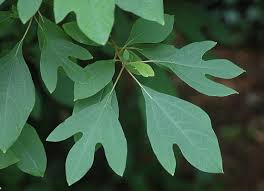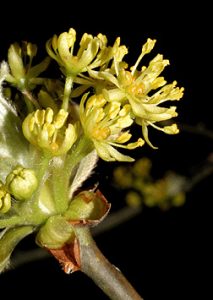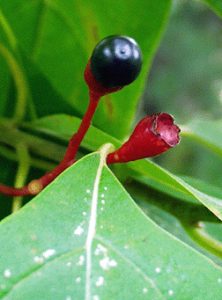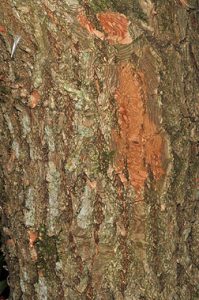Name That Tree
By Pat Dickey, Fairfax Master Gardener
 If you guessed Sassafras, you are correct. The Sassafras tree (Sassafras albidum) is native to the eastern part of the United States and Canada, and west to Missouri and Texas. It grows to 60 feet and can have a twisted trunk. Its brown bark has ridges and furrows and smells spicy when cut. The inner bark is cinnamon-brown in color. Sassafras trees grow at the edge of wooded areas, along fence rows, in fields and thickets and along roadsides. Native Americans made tea from the bark of the sassafras and flavored root beer with the roots. Recently, the oils have been found to be carcinogenic, containing the substance safrole. They are now banned from these uses by the Food and Drug Administration.
If you guessed Sassafras, you are correct. The Sassafras tree (Sassafras albidum) is native to the eastern part of the United States and Canada, and west to Missouri and Texas. It grows to 60 feet and can have a twisted trunk. Its brown bark has ridges and furrows and smells spicy when cut. The inner bark is cinnamon-brown in color. Sassafras trees grow at the edge of wooded areas, along fence rows, in fields and thickets and along roadsides. Native Americans made tea from the bark of the sassafras and flavored root beer with the roots. Recently, the oils have been found to be carcinogenic, containing the substance safrole. They are now banned from these uses by the Food and Drug Administration.

Sassafras flowers
Sassafras trees are dioecious, with male and female trees and flowers. Their bright yellow-green flowers bloom in mid-spring and are on 2-inch racemes. The fruit of the sassafras are dark, shiny blue, fleshy oval drupes in red cups, hanging from red stalks. These drupes mature in September, and birds are attracted to them.

Sassafras fruit
A sassafras tree can be suitable as a lawn specimen but requires plenty of space to grow. It is also alleopathic, meaning that it can discourage or affect the growth of other plants in its root zone.
This native tree is the larval host to the spicebush butterfly, the tiger swallowtail butterfly and the pale swallowtail. It will tolerate deer browsing.

Sassafras bark
References
Sassafras albidum, Lady Bird Johnson Wildflower Center, Austin, TX.
Sassafras albidum, Missouri Botanical Gardens